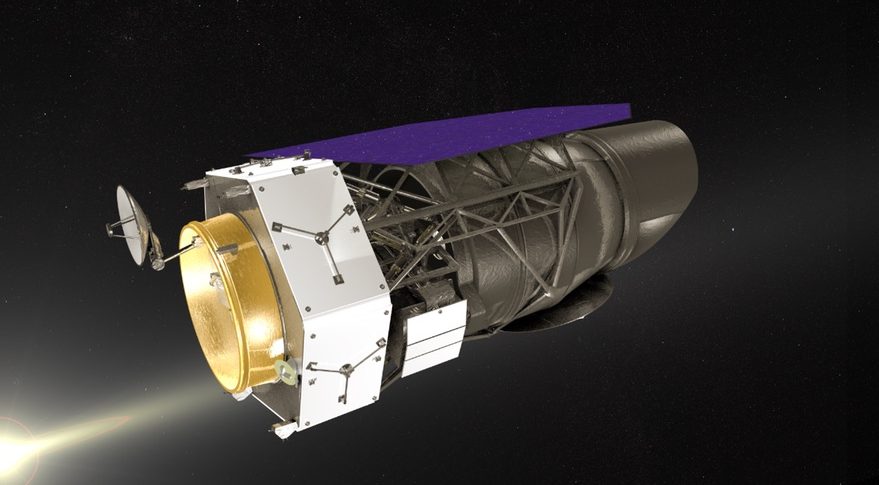NASA's WFIRST Space Telescope Faces Funding Crunch

WASHINGTON — A NASA astrophysics mission that avoided cancellation last year could still face budget problems if it evades another termination threat this year, agency officials warned this week.
NASA's fiscal year 2020 budget request includes no funding for the Wide Field Infrared Survey Telescope (WFIRST), the next large strategic, or flagship, astrophysics mission for the agency after the James Webb Space Telescope. NASA, in its request, said that it proposed cancelling the mission because of "its significant cost and higher priorities within NASA, including completing the delayed James Webb Space Telescope."
WFIRST was the top-ranked flagship mission in the latest astrophysics decadal survey, published in 2010. The spacecraft, featuring a 2.4-meter primary mirror provided to NASA by the National Reconnaissance Office, is designed to carry out research ranging from exoplanets to dark matter and dark energy. The mission, currently cost-capped at $3.2 billion, is scheduled for launch in 2025.
At a March 27 hearing of the commerce, justice and science subcommittee of the House Appropriations Committee, Rep. José Serrano (D-N.Y.), chairman of the subcommittee, asked NASA Administrator Jim Bridenstine about the proposed cancellation of WFIRST, noting the ability of WFIRST to work in concert with JWST. "If one was built to work with the other, why is WFIRST considered for elimination?" he asked.
Bridenstine pointed out the cost and schedule overruns of JWST. "We're now getting it back on track," he said. "If James Webb isn't yet ready, preparing WFIRST right away is probably not the right approach." He emphasized the importance of having a portfolio of both large and smaller missions.
He suggested WFIRST could be revived once JWST is launched. "WFIRST will be a critical mission when James Webb is on orbit," he said.
The administration's fiscal year 2019 budget request also proposed cancelling WFIRST. However, the final spending bill enacted in February ignored that request, providing the mission with $312 million for 2019.
Get the Space.com Newsletter
Breaking space news, the latest updates on rocket launches, skywatching events and more!
That funding, though, was less than what's needed to keep the mission on schedule, Paul Hertz, director of NASA's astrophysics mission, said in a March 26 presentation to the National Academies' Committee on Astronomy and Astrophysics. The budget profile established for the mission at a project milestone known as Key Decision Point B estimated WFIRST needed $372 million in 2019 to stay within budget and schedule.
"This does mean that $60 million worth of work that they had been planning to do in FY '19 is being deferred into later years, which has an impact downstream," Hertz said. WFIRST is maintaining its $3.2 billion cost for now, he said, "but the risk associated with making that target has changed."
Should Congress reject the administration's proposal to terminate WFIRST, Hertz said the project will need even more funding in fiscal year 2020 to remain on schedule. "We need $542 million in FY '20 to stay on track for delivering within our cost target," he said. That includes additional funding to catch up from the fiscal year 2019 shortfall.
If Congress does fund WFIRST, but below the $542 million required to stay on schedule, Hertz said NASA has two options. "We will have to choose between either blowing the cost target and having a larger run-out cost because we had to slow down, or descoping something significant" from the mission, he said.
In the latter case, the only significant thing that could be removed is the coronagraph, an instrument previously scaled back to a technology demonstration in order to fit the mission into the current $3.2 billion cost cap. That decision, if needed, would come when WFIRST reaches Key Decision Point C in early 2020.
Despite the uncertain fiscal landscape, work on the mission continues. "Over the last year, we got a lot of things in place," said Jamie Dunn, WFIRST project manager, at the committee meeting, including awarding contracts for key elements of the spacecraft. "We're poised to make really good progress this year."
A preliminary design review for the overall mission is scheduled for October. That would be followed by Key Decision Point C and formal mission confirmation, he said. "It would be good to get the required funding to pull that off."
- Read SpaceNews for the Latest Space Industry News
- What Would It Mean for Astronomers If the WFIRST Space Telescope Is Killed?
- Astronomers Will Fight to Save WFIRST Space Telescope from Being Axed
This story was provided by SpaceNews, dedicated to covering all aspects of the space industry.
Join our Space Forums to keep talking space on the latest missions, night sky and more! And if you have a news tip, correction or comment, let us know at: community@space.com.

Jeff Foust is a Senior Staff Writer at SpaceNews, a space industry news magazine and website, where he writes about space policy, commercial spaceflight and other aerospace industry topics. Jeff has a Ph.D. in planetary sciences from the Massachusetts Institute of Technology and earned a bachelor's degree in geophysics and planetary science from the California Institute of Technology. You can see Jeff's latest projects by following him on Twitter.










